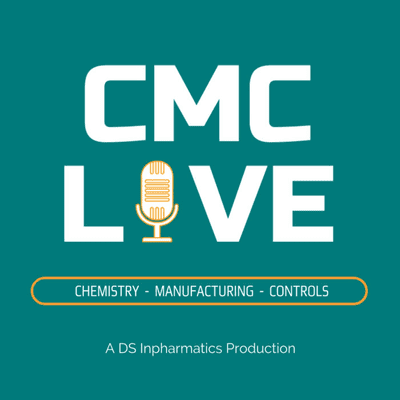
CMC Live - Chemistry, Manufacturing & Controls
Podcast von Meranda Parascandola, Ed Narke
Nimm diesen Podcast mit

Mehr als 1 Million Hörer*innen
Du wirst Podimo lieben und damit bist du nicht allein
Mit 4,7 Sternen im App Store bewertet
Alle Folgen
27 FolgenWHAT WE COVERED * 00:55 – Ed, Meranda and Brian welcome today’s guest, Mike Carroll, who speaks to his background in microbiology and product development * 04:28 – Mike talks about his involvement in the Parenteral Drug Association (PDA) * 07:51 – Lessons Mike has learned throughout his career and expounds on the relevance of PDA technical reports * 15:03 – The evolution of regulatory approvals in the pharmaceutical industry * 17:34 – Mike describes the influence of the PDA today, given the pandemic * 20:18 – Mike explains a typical day working in microbiology and quality control and assurance * 23:11 – The pressure of working in pharmaceutical drug development and final comments from Mike TWEETABLE QUOTES “The PDA was kind of the bridge. It’s the Parenteral Drug Association – its focus is sterile injectable product. But it’s into all kinds of different things.” “The biggest things that are most frequently used in my case are the media fill, as Brian mentioned, and environmental monitoring.” “When you cite regulations from Europe, it used to be you would pull the British because they were gonna be the standard. If you could pass Brit, you could worry about anybody else at all; you were fine.” “It’s an entire system that you’re trying to get where every little thing that fits into the process has been qualified and can be depended on. From the raw materials coming in the door to the viles, to the stoppers, to the machinery, the environment, the filters, the air quality and differentials – all of that stuff fitting together.” “With drug development, you’re not having a life depend on you. You’re having tens of thousands of lives depend on you.” RELEVANT LINKS Design Space InPharmatics – LinkedIn [https://www.linkedin.com/company/design-space-inpharmatics-llc/] Design Space InPharmatics – Twitter [https://twitter.com/DSInPharmatics] Edward Narke on LinkedIn [https://www.linkedin.com/in/edwardnarke/] Michael Carroll on LinkedIn [https://www.linkedin.com/in/michael-carroll-9839773/] PDA [https://www.pda.org/]
WHAT WE COVERED * 00:54 – Ed, Meranda and Brian welcome a special panel of guests to break down today’s topic: Quality Management Systems (QMS) Explained! * 07:53 – The panel expounds on the timing necessary for QMS and what role the quality manual plays * 13:06 – The panel explains the Code of Federal Regulations (CFRs) * 17:30 – The panel defines Phase Appropriate as it pertains to QMS * 23:12 – Identifying which guiding documents to follow * 27:29 – The value in having an experience quality professional * 31:54 – Why a quality agreement is necessary * 35:32 – The panel provides final words of wisdom on Quality Systems Management TWEETABLE QUOTES “Quality System Management provides an infrastructure for a company to ensure the quality of your drug product with patient safety in mind as its primary function.” “It helps determine and define management’s commitment to quality. Because if you don’t have senior management commitment, all could be lost.” “To begin at the beginning, when you set up your QMS, you need to start with the procedures and processes that will reduce risk and help you prepare for your submission in the long run. That would come through managing your documents.” “Guidance documents are just an opinion. And they actually say that in the documents. So, you kinda try to do a combination of everything.” “The biggest thing is that when you have somebody who’s experienced and they’ve been through various things like FDA audits or have worked with a very small company versus a very large company, they can differentiate what you really need right now.” RELEVANT LINKS Design Space InPharmatics – LinkedIn [https://www.linkedin.com/company/design-space-inpharmatics-llc/] Design Space InPharmatics – Twitter [https://twitter.com/DSInPharmatics] Edward Narke on LinkedIn [https://www.linkedin.com/in/edwardnarke/] Bettina Kaplan on LinkedIn [https://www.linkedin.com/in/bettina-kaplan-6826702/] Susan Fasso on LinkedIn [https://www.linkedin.com/in/susan-fasso-9b19244/] Robbi Freisem on LinkedIn [https://www.linkedin.com/in/robbifreisem/] Maria Arakil on LinkedIn [https://www.linkedin.com/in/maria-arakil-07b45628/]
WHAT WE COVERED * 00:52 – Ed, Meranda and Brian welcome back Jim Mencel who shares his extensive experience with process validation * 07:46 – The importance of Proven Acceptable Range (PAR) and Critical Process Parameter Program (CPP) * 11:14 – The evolution of the batch documentation and the value of critical parameter studies * 18:07 – Registration laws and gathering necessary stability data * 20:49 – How validation material can be used for launch * 24:15 – Jim speaks to the importance of writing a Protocol and having a quality supplier team * 32:34 – Jim discusses timing when moving towards validation * 38:02 – Jim reinforces the notion that communication is key when it comes to process validation * 40:42 – Final recommendations Jim would give regarding process validation TWEETABLE QUOTES “Validation’s very formal. Validation really, in a stage analogy, is Opening Night. This is where the critics are all present, everybody’s breathing on you, you’re gonna be in the headlines the next day and everything needs to go right. So, when you think about it in that context, the validation batches are very visible to regulatory authorities.” “Your batch record really is a document that’s going to evolve. And if you look at the batch record for even the same step of a process, what that’s going to look like when you’re in the early phases of clinical development is different from what it’s going to look like towards the end. It’s going to be much more refined.” “There is a point where the process is the process. And as inefficient as it may be, it’s what you have.” “Yes, your validation batches certainly count as launch stock as long as they pass all specs.” “When you go into validation, you’ve gotta have your suppliers identified. And quality plays a huge role in assessing your suppliers” “What it all comes down to is that preparing for the validation is something that you should be thinking about as you’re making your later clinical batches, your Phase 2 batches especially.” “When you’re in Phase Three it’s not a place to be penny-pinching. The old saying is, ‘you drive for show, you put for dough.’ When you’re validating, you’re putting for dough.” RELEVANT LINKS Design Space InPharmatics – LinkedIn [https://www.linkedin.com/company/design-space-inpharmatics-llc/] Design Space InPharmatics – Twitter [https://twitter.com/DSInPharmatics] Edward Narke on LinkedIn [https://www.linkedin.com/in/edwardnarke/] Jim Mencel on LinkedIn [https://www.linkedin.com/in/jim-mencel-7a31b010/]
WHAT WE COVERED * 00:51 – Ed, Meranda and Brian introduce today’s guest, Shelli Connelly, who discusses her background and speaks to some of the elements of filter validation * 05:41 – Shelli talks about the process of selecting a filter and why not all filters are the same * 09:03 – The evolution and importance of sizing filters * 11:26 – Shelli speaks to the shift to single-use disposable filters * 13:05 – Qualifying a filter before validation * 16:51 – Shelli explains the Bubble Point test * 18:53 – Shelli expounds on everything that goes into filter validation * 22:57 – How to use filters in a media simulation challenge * 25:07 – Shelli’s philosophy on what to include in your filter validation * 28:28 – Final recommendations Shelli would give regarding filter validation TWEETABLE QUOTES “I highly recommend reaching out to the filter vendors. They’re your best support, especially with this process.” “Most people when you start with a drug process you’re looking less than a hundred liters, knowing that your commercial back size could actually be 1500 liters. And then the question comes down to are you doing redundant filtration, are you utilizing two filters, are you utilizing one? To understand your product, I think the filter vendor can definitely still help with that.” “Normally if you’re utilizing a sterilizing filter, you definitely have to run it through some type of sterilization process.” “A Bubble Point test is related to the micron-size of your filter, meaning if you have a 0.2 or a 0.45, those bubble points are gonna be different.” “I think utilizing your filter validation in conjunction with your media fill program – whatever that may be – they have to be synced and in alignment.” RELEVANT LINKS Design Space InPharmatics – LinkedIn [https://www.linkedin.com/company/design-space-inpharmatics-llc/] Design Space InPharmatics – Twitter [https://twitter.com/DSInPharmatics] Edward Narke on LinkedIn [https://www.linkedin.com/in/edwardnarke/] Shelli Connelly on LinkedIn [https://www.linkedin.com/in/shelli-connelly-79234810]
WHAT WE COVERED * 00:51 – Meranda and Ed discuss the Regulatory Odd Couple blog series and constructing the CTD Module 3 * 11:54 – Ed explains the importance of building the Quality Overall Summary (QOS) and the different starting points for drug process development * 19:45 – Ed and Meranda talk about characterization, the process of manufacturing drug substances/products and the importance of excipients * 37:44 – Ed expounds on the analytical aspect of API and regulatory drug development * 46:55 – Ed and Meranda share their thoughts on the process of packaging drug substances * 49:09 – Ed and Meranda discuss the role that stability plays in development methods * 53:42 – P2 Pharmaceutical Development TWEETABLE QUOTES “If anyone’s listening and not familiar with the drug development process, the one area that’s most important is the FDA guidance.” “Characterization is, in my mind, one of the fundamentals of a product and a process and a program. If you don’t know what you’re dealing with to start, it’s hard to catalog it, make it consistently and answer questions about it.” “This is probably, in some folks’ minds, the most important. It’s the manufacturing of the drug substance and the drug product. If you don’t have a process, you don’t have a product.” “There are a few caveats to excipients. One of the things you’ll want to recognize and a question that might come up is ‘are they of human or animal origin?’ And the other big thing is ‘are they novel?’” “Any changes to anything in the program – process-wise or control-wise – late in the game could be a problem because you’re gonna have to generate additional data. There’s an unknown there. What does that change mean?” RELEVANT LINKS Design Space InPharmatics – LinkedIn [https://www.linkedin.com/company/design-space-inpharmatics-llc/] Design Space InPharmatics – Twitter [https://twitter.com/DSInPharmatics] Edward Narke on LinkedIn [https://www.linkedin.com/in/edwardnarke/] Odd Couple Series [https://dsinpharmatics.com/p1-Characterization]























